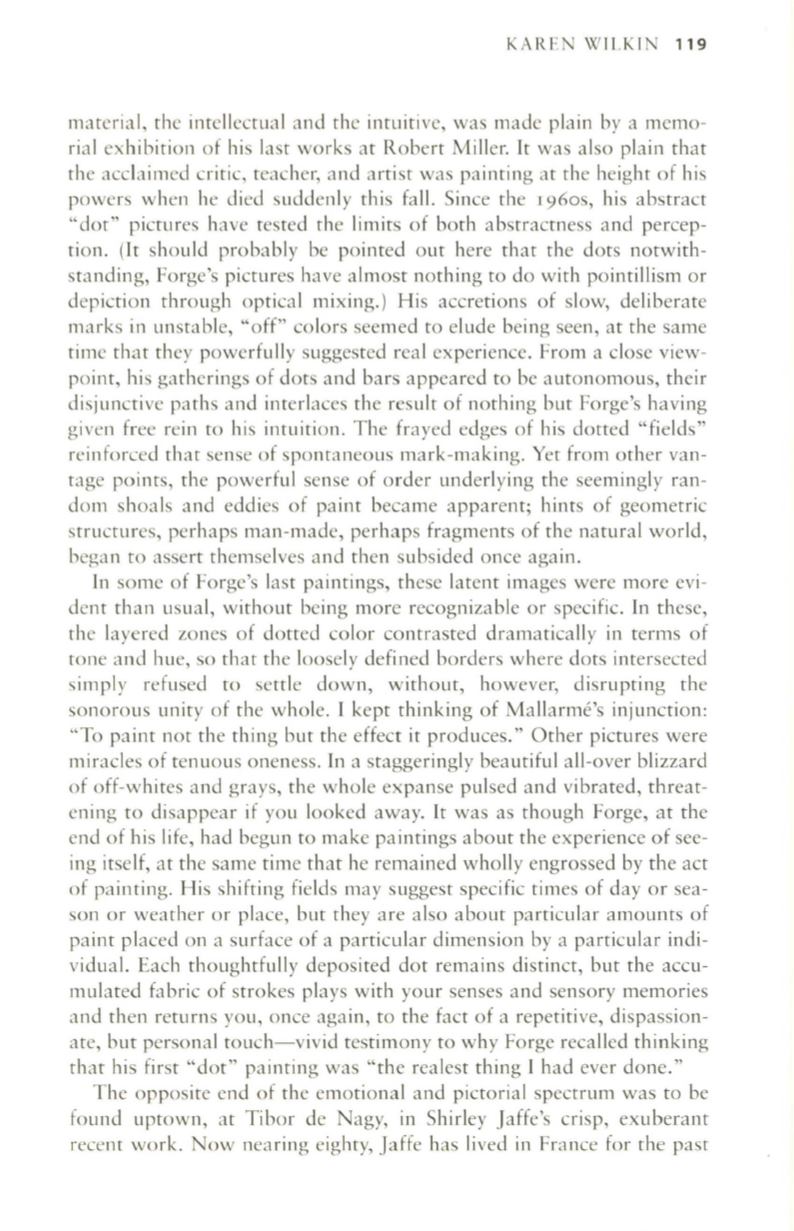
KAREN WILKIN
119
material, the intellectual and the intuitive, was made plain by a memo–
rial exhibition of his last works at Robert Miller. It was also plain that
the acclaimed critic, teacher, and artist was painting at the height of his
powers when he died suddenly this fall. Since the 1960s, his abstract
"dot" pictures have tested the limits of both abstractness and percep–
tion. (It should probably be pointed out here that the dots notwith–
standing, Forge's pictures have almost nothing to do with pointillism or
depiction through optical mixing.) His accretions of slow, deliberate
marks in unstable, "off" colors seemed to elude being seen, at the same
time that they powerfully suggested real experience. From a close view–
point, his gatherings of dots and bars appeared to be autonomous, their
disjunctive paths and interlaces the result of nothing but Forge's having
given free rein to his intuition. The frayed edges of his dotted "fields"
reinforced that sense of spontaneous mark-making. Yet from other van–
tage points, the powerful sense of order underlying the seemingly ran–
dom shoals and eddies of paint became apparent; hints of geometric
structures, perhaps man-made, perhaps fragments of the natural world,
began to assert themselves and then subsided once again.
In some of Forge's last paintings, these latent images were more evi–
dent than usual, without being more recognizable or specific. In these,
the layered zones of dotted color contrasted dramatically in terms of
tone and hue, so that the loosely defined borders where dots intersected
simply refused to settle down, without, however, disrupting the
sonorous unity of the whole. I kept thinking of Mallarme's injunction:
"To paint not the thing but the effect it produces." Other pictures were
miracles of tenuous oneness. In a staggeringly beautiful all-over blizzard
of off-whites and grays, the whole expanse pulsed and vibrated, threat–
ening to disappear if you looked away. It was as though Forge, at the
end of his life, had begun to make paintings about the experience of see–
ing itself, at the same time that he remained wholly engrossed by the act
of painting. His shifting fields may suggest specific times of day or sea–
son or weather or place, but they are also about particular amounts of
paint placed on a surface of a particular dimension by a particular indi–
vidual. Each thoughtfully deposited dot remains distinct, but the accu–
mulated fabric of strokes plays with your senses and sensory memories
and then returns you, once again, to the fact of a repetitive, dispassion–
ate, but personal touch-vivid testimony to why Forge recalled thinking
that his first "dot" painting was "the realest thing [ had ever done."
The opposite end of the emotional and pictorial spectrum was to be
found uptown, at Tibor de Nagy, in Shirley jaffe's crisp, exuberant
recent work. Now nearing eighty, Jaffe has lived in France for the past


